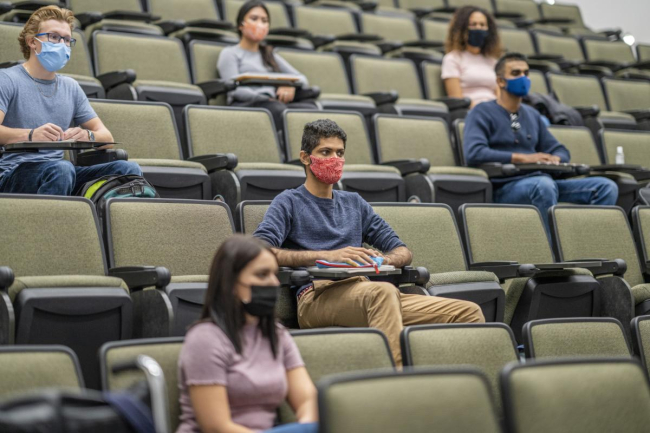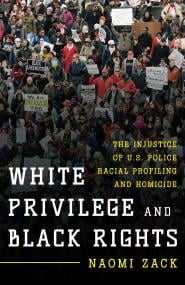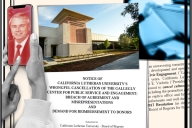You have /5 articles left.
Sign up for a free account or log in.

Undergraduate enrollment fell by 4.7 percent in spring 2022, though the number of first-time freshmen increased by 13,700 nationwide.
FatCamera/E+/Getty Images
Enrollment across all sectors of higher education continued to decline this past semester, extending a trend that began during the coronavirus pandemic, according to new data from the National Student Clearinghouse Research Center. Total enrollment for spring 2022 fell by 4.1 percent.
The latest numbers mark the fifth semester in a row of declining overall enrollment. The report from spring 2020 counted 17.1 million students across all levels of higher education; that number is now 15.9 million.
The decline is even more marked at the undergraduate level, where NSC data show an enrollment drop of 4.7 percent for spring 2022. By the numbers, that means undergraduate enrollment fell by 662,000 students in spring 2022 and has dipped by around 1.4 million since the onset of the pandemic in 2020, according to the data released today.
Though much of the report may be concerning for higher education, first-time freshman enrollment is a bright spot in the latest data, up by 4.2 percent, or 13,700 students. That reverses a decline of 3.5 percent, or 11,800 students, from last spring. However, a special analysis in this year’s report broke down the first-time freshman data by race, and it showed a 6.5 percent decline in Black freshman enrollment compared to last spring. Black students were the only demographic that declined among first-time freshmen.
Unpacking the Numbers
National Student Clearinghouse Research Center officials discussed the latest data during a Wednesday press call, touching on the highlights and low points of the report.
“I’m not surprised by the ongoing [decline]. I am surprised that it seems to be getting worse,” said Doug Shapiro, executive research director for the National Student Clearinghouse. “I thought we would start to see some of these declines begin to shrink a little bit this term, particularly because I think there’s a general sense that we should be coming out of the effects of the pandemic at this point.”
The ongoing enrollment slide indicates that there’s more at play than the lingering impact of the pandemic.
“It suggests that there is a broader questioning of the value of college and particularly concerns about student debt and paying for college and the potential labor market returns,” Shapiro said.
Broken down by sector, the new data show public community colleges are again hit the hardest on enrollment, experiencing a 7.8 percent enrollment decline over spring 2021. Public four-year colleges saw the second biggest decline, at 3.4 percent, followed by a 1.7 percent slide at private nonprofit four-year colleges and a 0.2 percent dip at private for-profit four-year colleges.

The number of full-time students slipped by 3.8 percent, while part-time enrollment fell by 4.5 percent.
Looking at states, California saw the most significant enrollment decline this spring at 8.1 percent, followed by Vermont and Washington, which both saw slides of 7.2 percent. Though data for Michigan seem to indicate a 15.5 percent enrollment decline, a note in the NSC report indicates those numbers may be inaccurate due to years of inconsistent data reporting.
Excluding states where an NSC footnote indicates data were “impacted by the reclassification of former multi-state for-profit four-year institutions” or states that had inconsistent data submission, New Hampshire experienced the largest rate of student growth at 8.2 percent, which Shapiro attributed to increased enrollment in online education. Of states where data was consistently reported, only five others—Arizona, Montana, South Carolina, Utah and West Virginia—plus Washington, D.C., saw increases, none higher than 3 percent.
The Big Picture
Some higher education observers expressed alarm at the latest National Student Clearinghouse report.
“These ongoing enrollment declines demand immediate attention from all who support students in high school, in postsecondary institutions, and in the workforce,” Kim Cook, CEO of the National College Attainment Network, wrote in an emailed statement to Inside Higher Ed. “We are particularly concerned that inequities in college attainment will persist for Black students and community college students, whose enrollment has declined at the highest rates.”
Kathy Dawley, who works on enrollment initiatives at EAB, a higher education consulting firm, noted that while the report highlights a number of challenges for higher education, there is at least a silver lining in terms of increased enrollment for first-time freshmen this spring semester.
But the downward trend for Black students in that freshman class is worrisome, she added.
“We know that particular pandemic-related stressors threatened some real significant progress we were making, particularly by ethnicity and by income-disadvantaged kids,” Dawley said. “The report is most alarming, really, for Black and African American students.”









.jpg?itok=nC76ZX1j)